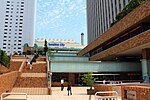Ikebukuro Station

Ikebukuro Station (Japanese: 池袋駅, Japanese pronunciation: [Ikebukuro-eki]) is a major railway station located in the Ikebukuro district of Toshima, Tokyo, Japan, shared by the East Japan Railway Company (JR East), Tokyo subway operator Tokyo Metro, and the two private railway operators Seibu Railway and Tobu Railway. With 2.71 million passengers on an average daily in 2007, it is the second-busiest railway station in the world (after Shinjuku Station), and the busiest station in the Tobu, Seibu, and Tokyo Metro networks. It primarily serves commuters from Saitama Prefecture and other residential areas northwest of the city center. It is the Tokyo terminal of the Seibu Ikebukuro Line and the Tobu Tojo Line.
Excerpt from the Wikipedia article Ikebukuro Station (License: CC BY-SA 3.0, Authors, Images).Ikebukuro Station
Entrace Footway, Toshima
Geographical coordinates (GPS) Address External links Nearby Places Show on map
Geographical coordinates (GPS)
| Latitude | Longitude |
|---|---|
| N 35.730277777778 ° | E 139.71138888889 ° |
Address
池袋
Entrace Footway
171-8512 Toshima
Japan
Open on Google Maps










